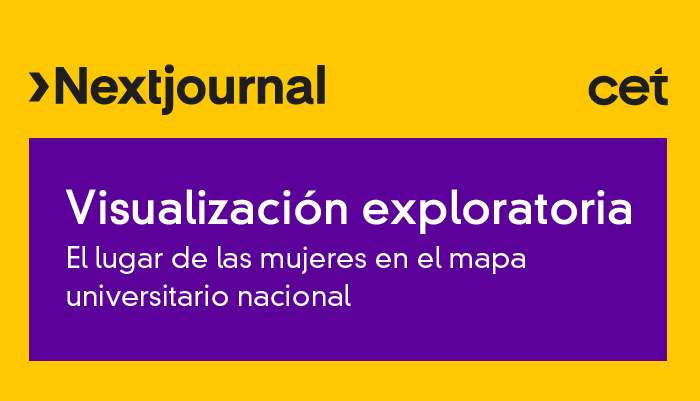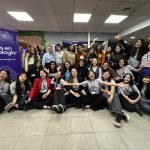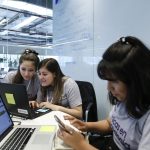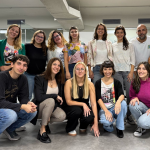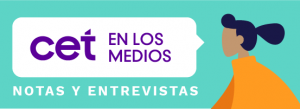Open data: Knowledge for change
Making stories visible from specific data, opening paths to new research, dimensioning contexts based on local data and disseminating actions that seek to reduce the gender gap in technology are just some of the possibilities that are opened from the new project of data visualization presented by Chicas en Tecnología (CET) during an online event on October 15.
“Exploratory visualization. The place of women in the national university map” brings together all the open and public databases generated by Chicas en Tecnología to carry out quantitative and qualitative research on the presence of women in STEAM disciplines (Science, Technology, Engineering, Art and Mathematics). Transforming this data set -which encompasses undergraduate, graduate and postgraduate courses of all Argentine universities- into accessible and organized information enables different actors in society to consult, disseminate and expand it, since a platform was used that allows collaborative work.
The data visualization project is one of the ways for information to circulate in society and to encourage decision-making and the creation of public policies to reduce the gender gap in the technology sector. Carolina Hadad, Co-founder of Chicas en Tecnología, led the project together with a group of specialists and at the presentation event she shared some of the possible scope of the visualizations: “The data set we use is very rich. Chicas en Tecnología decided to focus on gender issues but many other analyzes can be carried out as well, for example, the number of registrations in undergraduate, graduate and postgraduate degrees, or the virtual and face-to-face modality, or what happens with the public and private system. The visualizations we make are interactive and the code that reads, analyzes and visualizes the data is visible, open and free”. Romina Colman, a data journalist who has accompanied the organization since its first Research initiatives, referred to the importance of transforming data into advocacy: “When there are educational policies that seek to increase the presence of women in technology, how do enrollments respond after those policies are implemented? We have to start looking at the impacts of these policies but also start making decisions with data. And to highlight that behind these bases there are stories that need to be told and that data is the perfect excuse to achieve changes in society ”.
For the presentation event, Chicas en Tecnología invited representatives from the public sector, the educational field and the media: “Journalism and people in communication roles have a key place in the challenge of putting gender issues in the technological field in the public agenda through quality, updated and accessible information. The public sector is the one that can generate policies to transform current scenarios and the educational field is the central place where these changes must begin to be generated to build more diverse and inclusive environments based on long-term sustainable transformations”, Julieta La Casa, from the Girls in Technology Communication team, said at the opening of the event.
What is not measured cannot be improved, that is why the event had a panel moderated by Melina Masnatta, Executive Director of the organization, in which people from the field of communication, academia and the public sector shared about the opportunities and possibilities of incidence on the toppic of gender and diversity through the publication of updated and local data. Stephanie Hindi, journalist and specialist in strategic communication, emphasized the importance of knowing the users and recipients to whom the information is approached, and Florencia Tuchin, journalist specialized in sustainability and human development, highlighted the need to illustrate the data through stories: “With stories that help to make a problem visible, it is how you try to influence the public agenda and put an issue in relevance.”
A key setting where action must be taken to promote the inclusion of women in STEAM disciplines is the academy. Sandra Giunta, Secretariat of Science and Technology and Regional Studies of the National University of Jujuy shared some of the incentives that are being carried out to integrate more women into the scientific and technological system of the University and, regarding the research projects led by women researchers, she said: “The lines of research that aim to study new applied technologies, computer science and renewable energy research have grown. This scenario is complemented by the permanent availability of spaces for discussion, expression and exchange among women scientists ”.
Transforming data into actions that help solve the problem of the gender gap in technology depends on the essential role of the public sector that can generate policies and initiatives at the national level. The Ministry of Science, Technology and Innovation shared the main axes of the National Program for Gender Equality in Science, Technology and Innovation. “We believe that part of all this that we try to promote has to be accompanied by a cultural change, to break with stereotypes, to make inequities visible. It is a multiple strategy and evidence from the data is a part of a comprehensive policy”, said Victoria Tignino, Executive Secretary of the Program. Furthermore, Guillermina D’Onofrio, National Director of Competitive Programs and Projects at the Ministry of Science, Technology and Innovation, concluded: “It would be very desirable if we could gradually converge towards more participatory and democratic public policies. That each person can analyze data and influence decision-making. Data does not ensure that a reality will change but it does ensure that in a discussion one can position itself in another way because he/she will be able to discuss but learning to dialogue with diversity ”.
Open data
In 2019, Chicas en Tecnología was one of three organizations from around the world to win a Nextjournal grant to conduct exploratory visualization on a community-relevant dataset. The data visualization proposal created by the organization allows people to interact with the graphics in order to focus on the information they consider most relevant. In addition, the platform uses open source graphical schemas, meaning that anyone can replicate them and use them with another set of data. For example: other countries can use this proposal with local data to generate accessible information about their own situation. Whether to carry out an analysis with a gender perspective or on other topics, all the tools used by Chicas en Tecnología are available to be improved and shared by the public.
Knowledge for change
* 6 out of 100 people enrolled in the university correspond to computer-related careers. Only 1 of those 6 people is a woman
* +9 out of 10 people who enroll to work in primary and special education are women. Of the people who decide to specialize in Educational Technology, 6 out of every 10 are women.
* In Apparel and Textile Design, from 100 people registered, more than 95 are women. Videogame design has 5 women out of every 100 registrations.
* Computer Engineering has 1 woman out of every 10 students.
> Access link to the visualizations:
http://bit.ly/cet-visualizacion-exploratoria

